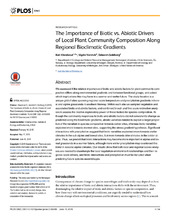| dc.contributor.author | Klanderud, Kari | |
| dc.contributor.author | Vandvik, Vigdis | |
| dc.contributor.author | Goldberg, Deborah | |
| dc.date.accessioned | 2016-02-22T14:22:10Z | |
| dc.date.available | 2016-02-22T14:22:10Z | |
| dc.date.issued | 2015-06-19 | |
| dc.Published | PLoS ONE 2015, 10(6): e0130205 | eng |
| dc.identifier.issn | 1932-6203 | en_US |
| dc.identifier.uri | http://hdl.handle.net/1956/11243 | |
| dc.description.abstract | We assessed if the relative importance of biotic and abiotic factors for plant community composition differs along environmental gradients and between functional groups, and asked which implications this may have in a warmer and wetter future. The study location is a unique grid of sites spanning regional-scale temperature and precipitation gradients in boreal and alpine grasslands in southern Norway. Within each site we sampled vegetation and associated biotic and abiotic factors, and combined broad- and fine-scale ordination analyses to assess the relative explanatory power of these factors for species composition. Although the community responses to biotic and abiotic factors did not consistently change as predicted along the bioclimatic gradients, abiotic variables tended to explain a larger proportion of the variation in species composition towards colder sites, whereas biotic variables explained more towards warmer sites, supporting the stress gradient hypothesis. Significant interactions with precipitation suggest that biotic variables explained more towards wetter climates in the sub alpine and boreal sites, but more towards drier climates in the colder alpine. Thus, we predict that biotic interactions may become more important in alpine and boreal grasslands in a warmer future, although more winter precipitation may counteract this trend in oceanic alpine climates. Our results show that both local and regional scales analyses are needed to disentangle the local vegetation-environment relationships and their regional- scale drivers, and biotic interactions and precipitation must be included when predicting future species assemblages. | en_US |
| dc.language.iso | eng | eng |
| dc.publisher | PLoS | en_US |
| dc.rights | Attribution CC BY | eng |
| dc.rights.uri | http://creativecommons.org/licenses/by/4.0/ | eng |
| dc.title | The importance of Biotic vs. Abiotic drivers of local plant community composition along regional bioclimatic gradients | en_US |
| dc.type | Peer reviewed | |
| dc.type | Journal article | |
| dc.date.updated | 2016-01-06T11:45:12Z | |
| dc.description.version | publishedVersion | en_US |
| dc.rights.holder | Copyright 2015 The Authors | en_US |
| dc.identifier.doi | https://doi.org/10.1371/journal.pone.0130205 | |
| dc.identifier.cristin | 1276961 | |
| dc.subject.nsi | VDP::Landbruks- og fiskerifag: 900::Landbruksfag: 910::Naturressursforvaltning: 914 | |
| dc.subject.nsi | VDP::Agriculture and fisheries science: 900::Agricultural sciences: 910::Natural resource management: 914 | |
| dc.subject.nsi | VDP::Matematikk og naturvitenskap: 400::Zoologiske og botaniske fag: 480::Plantegeografi: 496 | |
| dc.subject.nsi | VDP::Mathematics and natural scienses: 400::Zoology and botany: 480::Plant geography: 496 | |

